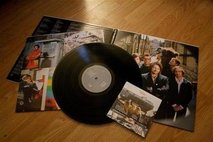 TORONTO – As music lovers approach a new decade in this still-young century, a recording technology once considered old and obsolete — vinyl — has been making a strong comeback.
TORONTO – As music lovers approach a new decade in this still-young century, a recording technology once considered old and obsolete — vinyl — has been making a strong comeback.
Vinyl albums, which began to be replaced by CDs in the mid-1980s, have rebounded in recent years as enthusiasts young and old turned sentimental for the old pops, cracks and warm sounds emitting from grooves on a record.
And as sales have rebounded, music makers ranging from big acts like Jack White and the Flaming Lips to local bands in major cities have been cranking out vinyl and treating fans with added material like old-style liner notes or posters.
If bands can keep costs low, they may even be able to make extra money in the financially-strapped music business where cheap digital downloads are replacing once-lucrative CD sales.
“It’s hard to say how long it’ll last, but even if you’re 16 years-old, your parents probably have vinyl somewhere,” said Wayne Coyne, lead singer of the Flaming Lips. “So there’s probably some trigger of another time, an exotic world where this was the way you bought music.”
While vinyl records never truly became extinct from record store shelves, the current resurgence seems to have picked up pace starting around 2007. Last year, 1.9 million vinyl records sold, roughly double 2007. Industry tracker Nielsen SoundScan projects that 2.8 million units will be purchased in 2009.
A wide range of bands, from Radiohead and the Beatles to Bob Dylan and Metallica, have been shipping albums on vinyl. Radiohead, for instance, sold 61,000 vinyl records in 2008.
Turntable sales are increasing, too, suggesting vinyl is reaching new customers and not just collectors and purists.
SEEING IS BELIEVING
Vinyl’s renaissance springs from both musicians and fans longing for something more tangible than just listening to music on a digital file, said Paul Simcoe, co-owner of Toronto’s Criminal Records.
“I’ll support an artist to the end of time,” he said. “But I still have a huge problem buying something I can’t see.”
The Flaming Lips’ Coyne said vinyl appeals to fans’ senses in ways digital downloads can’t by providing colorful notes, posters or other visual items that downloads just don’t have. In fact, his band has even packaged DVDs with vinyl albums.
Trevor Larocque, co-founder of Toronto’s Paper Bag Records, said vinyl gives artists the chance to offer fans distinct products. His label’s records are made in limited amounts of 200 or 300, and the record sleeves are silk-screened with exclusive artwork.
Another technique to lure online listeners is offering memberships in fan clubs that include shipments of unreleased, vinyl recordings, which is what Nashville-based Third Man Records, founded by the White Stripes’ Jack White, is doing.
“That, for us, is a really strong way of reaching out to a digital generation,” label executive Ben Swank said.
In the case of Toronto-based band the Diableros, they released a new EP, Old Story, Fresh Road, digitally and on vinyl, forgoing CDs which they felt were unnecessary.
But releasing an album on vinyl presents musicians with challenges that don’t exist for CDs or digital files, said David Read of Vinyl Record Guru, a manufacturing outfit on Vancouver Island, Canada.
COSTS VS. BENEFITS
Listeners can download files or copy digital songs onto CDs and DVDs from their home computer but vinyl presses aren’t easy to find — there are only a handful in North America. And to produce a vinyl album, first the lacquer on which to press each vinyl album must be made. Then, a test pressing needs to be done and sound problems must be fixed before mass quantities are produced.
Also, many bands want to release just a few hundred copies on vinyl, yet custom vinyl jackets must be ordered in minimum quantities of 500. To get around that problem, Paper Bag Records ships its albums in, aptly so, paper — recycled cardboard jackets that are customized for each band.
Diableros drummer Mike Duffield said his band borrowed money to finance its vinyl EP, but it was worth it.
“When you’ve worked a year and a half on something and you want to see it done, you take risks,” he explained. “I think you have to invest in yourself and your product.”
Vinyl records also cost fans more than CDs, said Criminal Record’s Simcoe.
CDs generally range from $10 to $14, but a vinyl record is usually at least $15. A price of $20 is more normal and a double-disc, for instance, can cost upward of $35.
Some major and independent labels have increased vinyl prices to account for higher costs and increased demand, but Simcoe worries that tactic may end the positive sales trend.
“These guys are in danger of killing this industry,” Simcoe said.
But for some artists, vinyl’s downsides are worth working around. Third Man Records, for instance, sidesteps higher costs and inconvenience by doing all their work in Nashville. The music is recorded in a studio behind their storefront and records are pressed at a facility just down the road.
“We can have it on the shelves in about a month, which is about as long as it takes to get it on iTunes these days,” Swank said. “What we’re trying to do is make vinyl as immediate as a digital track can be.”
The sale of vinyl records is one avenue the struggling recording industry is taking to increase profits. Whether or not the sale of vinyl albums can make up for lost CD sales remains to be seen, however.

